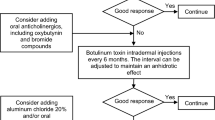Abstract
Background
Hypohidrosis can result in heat injury, a potentially fatal condition. The majority of hypohidrosis cases have no associated abnormalities or secondary causes, and are termed “isolated hypohidrosis”. These are clinically divided into miliaria profunda (MP), acquired idiopathic generalized anhidrosis (AIGA) and idiopathic partial hypohidrosis (IPH). The pathogenesis of isolated hypohidrosis remains largely unknown and there is no established effective treatment.
Objectives
To elucidate the pathogenesis of isolated hypohidrosis using in vivo high-definition optical coherence tomography (HD-OCT) imaging and assess the therapeutic profile of oral retinoids for this condition.
Materials & Methods
We conducted a retrospective analysis on all patients with isolated hypohidrosis in our neuro-dermatology clinic over a 5.75–year period. All patients routinely underwent standardised exercising and whole-body starch-iodine testing, followed by non-invasive HD-OCT skin imaging. Patients’ demographics, disease characteristics, histology and treatment history were analysed.
Results
Of the 51 patients identified with isolated hypohidrosis; 23 were diagnosed with MP, 14 with AIGA, and 14 with IPH. In these patients, HD-OCT imaging led to the identification of sub-stratum corneal hypo-refractile material with underlying dilated sweat ducts, not present in healthy controls. The size of this material was most pronounced in MP, followed by AIGA, and then IPH. Post-treatment, the material decreased in size. Treatment response was reported in 90.6% patients with isotretinoin and 75.0% with acitretin. No recurrence has been reported to date. Side effects were largely anticipated and common.
Conclusion
The pathogenesis of isolated hypohidrosis involves obstruction of sweat orifices at the stratum corneum. Treatment with oral retinoids, particularly isotretinoin, is effective and safe.
Similar content being viewed by others
References
Thami GP, Kaur S, Kanwar AJ. Acquired idiopathic generalized anhidrosis: a rare cause of heat intolerance. Clin Exp Dermatol 2003;28:262–4.
Lim JH, Kok WL, Ali NB, Chong WS, Tey HL. Hypohidrosis in individuals with exertional heat injury: a prospective open cohort study. Dermatology 2016; 232:50–6.
Hu Y, Converse C, Lyons MC, Hsu WH. Neural control of sweat secretion: a review. Br J Dermatol 2018; 178: 1246–56.
Roskind JL, Petrofsky J, Lind AR, Paletta FX. Quantitation of thermoregulatory impairment in patients with healed burns. Ann Plast Surg 1978; 1: 172–6.
Chia KY, Tey HL. Approach to hypohidrosis. J Eur Acad Dermatol Venereol 2013; 27:799–804.
Tey HL, Tay EY, Cao T. in vivo imaging of miliaria profunda using high-definition optical coherence tomography: diagnosis, pathogenesis, and treatment. JAMA Dermatol 2015; 151: 346–8.
Kirk JF, Wilson BB, Chun W, Cooper PH. Miliaria profunda. J Am Acad Dermatol 1996; 35: 854–6.
Chen YC, Wu CS, Chen GS, Khor GT, Chen CH, Huang P. Identification of subgroups of acquired idiopathic generalized anhidrosis. Neurologist 2008; 14:318–20.
Munetsugu T, Fujimoto T, Oshima Y, et al. Revised guideline for the diagnosis and treatment of acquired idiopathic generalized anhidrosis in Japan. J Dermatol 2017;44: 394400.
Ohshima Y, Yanagishita T, Ito K, et al. Treatment of patients with acquired idiopathic generalized anhidrosis. Br J Dermatol 2013; 168:430–2.
Palm F, Löser C, Gronau W, Voigtländer V, Grau AJ. Successful treatment of acquired idiopathic generalized anhidrosis. Neurology 2007; 68:532–3.
Fukunaga A, Hatakeyama M, Tsujimoto M, Oda Y, Washio K, Nishigori C. Steroid treatment can improve the impaired quality of life of patients with acquired idiopathic generalized anhidrosis. Br J Dermatol 2015;172:537.
Yoritaka A, Hishima T, Akagi K, Kishida S. Successful steroid treatment of acquired idiopathic partial hypohidrosis. J Dermatol 2006;33:265–7.
Fritsch PO. Retinoids in psoriasis and disorders of keratinization. J Am Acad Dermatol 1992; 27: S8–14.
von Elm E, Altman DG, Egger M, Pocock SJ, Gøtzsche PC, Vandenbroucke JP. The strengthening the reporting of observational studies in epidemiology (strobe) statement: guidelines for reporting observational studies. Lancet 2007; 370: 1453–7.
Narita K, Sakamoto S, Mizushige K, Senda S, Matsuo H. Development and evaluation of a new target heart rate formula for the adequate exercise training level in healthy subjects. J Cardiol 1999; 33: 265–72.
Lim JL, Choo W, Chang JH, Tey HL, Chong WS. Application of iodinated starch powder using an atomizer spray gun-a new and effective tool to evaluate hypohidrosis. Skin Res Technol 2016; 22: 370–4.
Wallace AB. The exposure treatment of burns. Lancet 1951; 1: 501–4.
Schneider CA, Rasband WS, Eliceiri KW. NIH Image to ImageJ: 25 years of image analysis. Nat Methods 2012; 9: 671.
R Core Team. R: A language and environment for statistical computing. Vienna: R Foundation for Statistical Computing; 2019. Available at: https://www.R-project.org.(accessed 11 March 2019).
Haenssle HA, Finkenrath A, Hausser I, et al. Effective treatment of severe thermodysregulation by oral retinoids in a patient with recessive congenital lamellar ichthyosis. Clin Exp Dermatol 2008; 33: 578–81.
Elias PM. Epidermal effects of retinoids: supramolecular observations and clinical implications. J Am Acad Dermatol 1986; 15: 797–809.
Törmä H. Regulation of keratin expression by retinoids. Dermatoendocrinol 2011; 3: 136–40.
Ormerod AD, Campalani E, Goodfield MJ. British Association of Dermatologists guidelines on the efficacy and use of acitretin in dermatology. Br J Dermatol 2010; 162:952–63.
Author information
Authors and Affiliations
Corresponding author
Additional information
Disclosure
Financial support: this study was supported by the Ministry of Health’s National Medical Research Council, Singapore, under the Clinician Scientist Award (NMRC/CSA-INV/0023/2017). Conflict of interests: none.
About this article
Cite this article
Chan, M.M.H., Lim, G.H., Zhao, X. et al. Isolated hypohidrosis: pathogenesis and treatment. Eur J Dermatol 30, 680–687 (2020). https://doi.org/10.1684/ejd.2020.3931
Accepted:
Published:
Issue Date:
DOI: https://doi.org/10.1684/ejd.2020.3931




